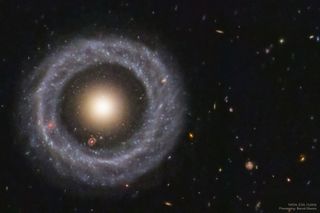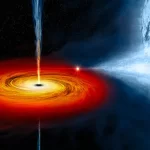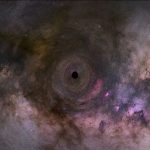Key Takeaways:
- Hoag’s Object is a rare, ring-shaped galaxy discovered by astronomer Arthur Hoag in 1950.
- It consists of a bright ring of blue stars encircling a smaller, denser sphere of reddish stars, with a distant ring galaxy in between.
- The exact cause of this unusual structure remains a mystery, as ring galaxies are exceptionally rare.
- Some hypotheses include gravitational lensing, but it has been disproven, and a collision with a neighboring galaxy, though no evidence supports this.
- With only a handful of known ring galaxies, Hoag’s Object continues to perplex astronomers.

If you turn your gaze to the serpent constellation in the northern sky, you might encounter a cosmic enigma that has puzzled astronomers since its discovery in 1950.
This celestial oddity, known as Hoag’s Object, is a rare ring-shaped galaxy, boasting a diameter of about 100,000 light-years, slightly larger than our own Milky Way. Located a staggering 600 million light-years from Earth, this galactic curiosity presents a structure that is nothing short of mind-boggling.
In a recent image captured by the Hubble Space Telescope and artfully processed by geophysicist Benoit Blanco, a brilliant ring of billions of blue stars elegantly forms a perfect circle around a much smaller and denser core of reddish stars.
But the intrigue doesn’t end there. Within the dark void between these two concentric stellar circles, yet another ring galaxy reveals itself, nestled much farther away in the cosmic expanse.
Astronomers continue to grapple with the fundamental questions surrounding Hoag’s Object. This peculiar ring galaxy presents a mystery, as ring galaxies represent an extremely rare class, accounting for less than 0.1% of all known galaxies.
One of the initial speculations, put forward by its discoverer Arthur Hoag, suggested that the striking ring formation was a mere optical illusion, a consequence of gravitational lensing. However, subsequent studies equipped with advanced telescopes have debunked this notion, leaving the puzzle unresolved.
Another prevailing hypothesis posits that Hoag’s Object may have originally been a conventional, disk-shaped galaxy that experienced a dramatic collision with a neighboring galaxy, resulting in a gaping hole through its disk and a permanent alteration of its gravitational forces.
If such an event transpired within the last 3 billion years, radio telescopes should have detected traces of this celestial crash. Yet, no such evidence has come to light.
If indeed a cosmic collision gave rise to Hoag’s Object, it appears to have occurred so far in the past that all traces have been swept away by the cosmic tides.
With only a handful of other ring galaxies known to science, none of which exhibit the symmetrical features found in Hoag’s Object, this celestial enigma remains an unsolved riddle, concealed within the layers of the cosmic universe, much like the layers of a turducken.


